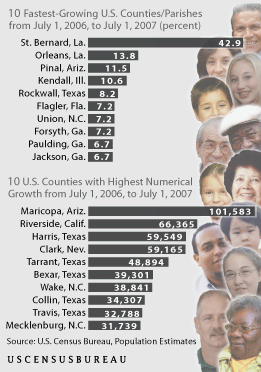
RELEASED: 12:01 A.M. EDT, THURSDAY, MARCH 20, 2008
- Robert Bernstein
- Public Information Office
- 301-763-3030/3762 (fax)
- 301-457-1037 (TDD)
- e-mail: <pio@census.gov>
- CB08-47
- Broadcast Release [PDF]
- Detailed tables
- State contacts
- Graphic [high res. jpg]
New Orleans’ Parishes Top Nation in Population Growth Rate
St. Bernard and Orleans, two Louisiana parishes hit hard by Hurricane Katrina in 2005, were the nation’s fastest-growing counties in 2007, according to population estimates released today by the U.S. Census Bureau.
 St. Bernard — the nation’s fastest-losing county from 2005 to 2006 — experienced a 42.9 percent population increase between July 1, 2006, and July 1, 2007, upping its population by almost 6,000. Orleans’ population rose by 13.8 percent, or nearly 29,000. (See Table 1 [Excel].)
St. Bernard — the nation’s fastest-losing county from 2005 to 2006 — experienced a 42.9 percent population increase between July 1, 2006, and July 1, 2007, upping its population by almost 6,000. Orleans’ population rose by 13.8 percent, or nearly 29,000. (See Table 1 [Excel].)
According to the estimates, all but one of the nation’s 10 fastest-growing counties were located in the South or West, with Pinal, Ariz. (near Phoenix) ranking third at 11.5 percent; Kendall, Ill. (in the Chicago area) fourth at 10.6 percent; Rockwall, Texas (in the Dallas area) fifth at 8.2 percent; Flagler, Fla. (between Daytona Beach and Jacksonville) sixth at 7.2 percent; and Union, N.C. (near Charlotte) seventh at 7.2 percent. Rounding out the list were three Georgia counties: Forsyth (7.2 percent), Paulding (6.7 percent) and Jackson (6.7 percent). Forsyth and Paulding are in the Atlanta metro area, with Jackson bordering on Athens-Clarke County.
Maricopa County, Ariz., home of Phoenix, was the top numerical gainer, increasing by 102,000 people between 2006 and 2007. Among the 10 counties that added the largest number of residents between 2006 and 2007, half were in Texas (Harris, Tarrant, Bexar, Collin and Travis), two in North Carolina (Wake and Mecklenburg), and one each in California (Riverside) and Nevada (Clark). (See Table 2 [Excel].)
Los Angeles, Calif., remained the most populous county, with a July 1, 2007, population of 9.9 million, a decline of 2,000 residents from 2006.
Among Puerto Rico municipios, Toa Alta again had the largest numeric increase, gaining 2,000 residents between 2006 and 2007, as well as the highest rate of increase (3 percent). San Juan was the most populous in 2007, with 424,800 residents.
Other highlights:
2006-2007:
- Seventy of the 100 fastest-growing counties were in the South, with 22 in the West and eight in the Midwest.
- Among the 100 fastest-growing counties, more than one-third were in either Georgia (18) or Texas (16).
- Texas was home to 11 counties among the 25 with the highest numerical gains. Each of the top 25 was in the South or West.
2000-2007:
- The fastest-growing county was Kendall, Ill., with a population growth of 77.5 percent from April 1, 2000, to July 1, 2007. Kendall edged out Flagler, Fla. (77.4 percent). Rounding out the top 10 were Rockwall, Texas (71.3 percent); Pinal, Ariz. (66.5 percent); Loudoun, Va. (64.4 percent); Forsyth, Ga. (61.5 percent); Paulding, Ga. (56.7 percent); Lincoln, S.D. (56.4 percent); Henry, Ga. (55.9 percent); and Newton, Ga. (54.9 percent).
- Maricopa County, Ariz., had the largest numeric increase from 2000 to 2007, adding 808,000 residents. Harris, Texas (535,000); Riverside, Calif. (528,000); Clark, Nev. (461,000); and Los Angeles, Calif. (359,000) followed. Texas was the home to nine of the top 25 numeric gainers, and California to six.
- Ten counties gained more than 200,000 residents from 2000 to 2007.
- Among Puerto Rico municipios, Toa Alta experienced the largest numerical gain (16,000), with Florida having the highest rate of increase (26.2 percent).
The Census Bureau’s Internet tables show July 1 population estimates for 2000 through 2007, as well as the April 1, 2000, census counts. Also included are rankings and estimates of components of population change (births, deaths, net internal migration and net international migration) for all counties. The data in this news release on population change apply only to counties with total populations of 10,000 or more.
